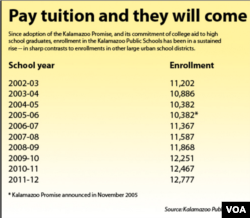For the past decade, secret donors have paid tuition for students who graduate from Kalamazoo public schools to attend public universities in Michigan.
“I don’t think I would be in the same place in life right now if it wasn’t for this program,” said Emily Olivares, 22.
A program called Kalamazoo Promise paid for Olivares’ tuition and fees for four years -- nearly $54,000 -- at Western Michigan University.
Since graduating, Emily is working for Kalamazoo Promise. In the future, she said she hopes to set up international study programs for college students.
The Kalamazoo program is getting more attention lately because the Democratic candidate for president, Hillary Clinton, is proposing a free-tuition program nationwide. Clinton wants to provide free state-college tuition for families with incomes up to $125,000.
Republican Donald Trump’s campaign website does not list a plan on college tuition. Last year, Trump told The Hill newspaper that the federal government should not profit on student loans and should allow students to lower the amount of interest they pay.
In Kalamazoo, the city’s tuition-aid program is praised as making a difference. The city has 76,000 residents and is halfway between the Midwest cities of Chicago, Illinois and Detroit, Michigan.
Bob Jorth, the Kalamazoo Promise executive director, said about 25 percent more Kalamazoo students attend college than 10 years ago, when the program began.
And it is sending about 85 percent of its high school graduates to college, a percentage Jorth said is similar to the rate in much wealthier communities.
Tinashe Chaponda, 21, attends Western Michigan University with help from Kalamazoo Promise.
Not having topay full tuition means he does not have to work for pay, Chaponda said. It has freed him to set up a non-profit group that helps place students as volunteers.
Chaponda came to Kalamazoo from Zimbabwe in Grade 8. Seventy percent of his tuition is paid by donors. For students who attend Kalamazoo public schools through Grade 12, their entire Michigan state college tuition is covered.
Chaponda said his goal is to return to Zimbabwe some day and run for president of the southern African country.
“The Promise program allows me to focus on college and still have extra time to start my non-profit,” Chaponda said. “I feel if people are investing in me, the least I can do is give back to the community in some way.”
Kalamazoo is not the only place with free- or reduced-cost tuition for public school graduates.
The Upjohn Institute for Employment Research reported that about 30 U.S. communities have created similar programs. One of the largest is in Pittsburgh, Pennsylvania.
Upjohn, in a 2015 study, said the Kalamazoo program led to a 12 percent increase in people earning college degrees within six years of high school graduation.
That is a big deal, according to the U.S. Education Department. People who graduate from college in America earn $1 million more over their lifetime than those who only graduated from high school.
The Promise program also means Kalamazoo public school graduates can attend state colleges without owing a lot of money. The average student debt for 2016 college graduates is $37,000, according to the website, StudentLoanHero.com.
Not everyone is sold on the idea of free tuition. Norbert Michel, writing for the conservative Heritage Foundation, said free tuition can lead to higher education costs.
“The core problem is that they remove the paying customer -- in this case the student -- from the equation,” Michel said. If students and their parents are paying, they will work to keep costs down, he said.
And the Brookings Institution published a report about Kalamazoo last summer called, "Free Tuition is Not Enough: The unavoidable limits of the Kalamazoo Promise." The rate at which students complete college -- or don't -- is an issue.
"Kalamazoo high school graduates were little, if any, more likely than their counterparts statewide to have earned 24 college credits within 16 months of graduating from high school," the 2015 report said. "White students were about twice as likely to have earned 24 credits than black students, as were middle-class students compared to the economically disadvantaged. There are also wide gaps by race and economic background in the chances of enrolling in four-year college versus community college."
Michael Rice is superintendent of Kalamazoo Public Schools. Teachers start talking about the program in early grades, Rice said.
“By sixth grade, students understand that this is something special and unique,” Rice said. He said the program has helped increase student test scores.
When Kalamazoo Promise was announced in late 2005, a press release said the donors wanted to give people a reason to remain in Kalamazoo or move to the city. They also wanted a more educated workforce. But the press release did not say who the donors are.
Ever since, Jorth said local residents have been trying to guess who in Kalamazoo has enough money to provide the $80 million given the program since 2006.
The secret donors make Jorth’s job pretty special. He may be one of the few people who can say, “I don’t know who I work for.”
“I don’t think I would be in the same place in life right now if it wasn’t for this program,” said Emily Olivares, 22.
A program called Kalamazoo Promise paid for Olivares’ tuition and fees for four years -- nearly $54,000 -- at Western Michigan University.
Since graduating, Emily is working for Kalamazoo Promise. In the future, she said she hopes to set up international study programs for college students.
The Kalamazoo program is getting more attention lately because the Democratic candidate for president, Hillary Clinton, is proposing a free-tuition program nationwide. Clinton wants to provide free state-college tuition for families with incomes up to $125,000.
Republican Donald Trump’s campaign website does not list a plan on college tuition. Last year, Trump told The Hill newspaper that the federal government should not profit on student loans and should allow students to lower the amount of interest they pay.
In Kalamazoo, the city’s tuition-aid program is praised as making a difference. The city has 76,000 residents and is halfway between the Midwest cities of Chicago, Illinois and Detroit, Michigan.
Bob Jorth, the Kalamazoo Promise executive director, said about 25 percent more Kalamazoo students attend college than 10 years ago, when the program began.
And it is sending about 85 percent of its high school graduates to college, a percentage Jorth said is similar to the rate in much wealthier communities.
Tinashe Chaponda, 21, attends Western Michigan University with help from Kalamazoo Promise.
Not having topay full tuition means he does not have to work for pay, Chaponda said. It has freed him to set up a non-profit group that helps place students as volunteers.
Chaponda came to Kalamazoo from Zimbabwe in Grade 8. Seventy percent of his tuition is paid by donors. For students who attend Kalamazoo public schools through Grade 12, their entire Michigan state college tuition is covered.
Chaponda said his goal is to return to Zimbabwe some day and run for president of the southern African country.
“The Promise program allows me to focus on college and still have extra time to start my non-profit,” Chaponda said. “I feel if people are investing in me, the least I can do is give back to the community in some way.”
Kalamazoo is not the only place with free- or reduced-cost tuition for public school graduates.
The Upjohn Institute for Employment Research reported that about 30 U.S. communities have created similar programs. One of the largest is in Pittsburgh, Pennsylvania.
Upjohn, in a 2015 study, said the Kalamazoo program led to a 12 percent increase in people earning college degrees within six years of high school graduation.
That is a big deal, according to the U.S. Education Department. People who graduate from college in America earn $1 million more over their lifetime than those who only graduated from high school.
The Promise program also means Kalamazoo public school graduates can attend state colleges without owing a lot of money. The average student debt for 2016 college graduates is $37,000, according to the website, StudentLoanHero.com.
Not everyone is sold on the idea of free tuition. Norbert Michel, writing for the conservative Heritage Foundation, said free tuition can lead to higher education costs.
“The core problem is that they remove the paying customer -- in this case the student -- from the equation,” Michel said. If students and their parents are paying, they will work to keep costs down, he said.
And the Brookings Institution published a report about Kalamazoo last summer called, "Free Tuition is Not Enough: The unavoidable limits of the Kalamazoo Promise." The rate at which students complete college -- or don't -- is an issue.
"Kalamazoo high school graduates were little, if any, more likely than their counterparts statewide to have earned 24 college credits within 16 months of graduating from high school," the 2015 report said. "White students were about twice as likely to have earned 24 credits than black students, as were middle-class students compared to the economically disadvantaged. There are also wide gaps by race and economic background in the chances of enrolling in four-year college versus community college."
Michael Rice is superintendent of Kalamazoo Public Schools. Teachers start talking about the program in early grades, Rice said.
“By sixth grade, students understand that this is something special and unique,” Rice said. He said the program has helped increase student test scores.
When Kalamazoo Promise was announced in late 2005, a press release said the donors wanted to give people a reason to remain in Kalamazoo or move to the city. They also wanted a more educated workforce. But the press release did not say who the donors are.
Ever since, Jorth said local residents have been trying to guess who in Kalamazoo has enough money to provide the $80 million given the program since 2006.
The secret donors make Jorth’s job pretty special. He may be one of the few people who can say, “I don’t know who I work for.”






